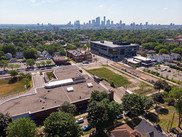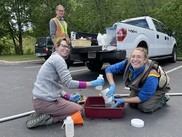MWMO Awards Funding for New Stormwater and Habitat Projects
Four new projects were approved by the MWMO Board of Commissioners at their July 13 meeting.
-
The City of Minneapolis was awarded a $500,000 Capital Project Grant for green stormwater infrastructure as part of a street reconstruction project near U.S. Bank Stadium in Downtown Minneapolis.
-
Juxtaposition Arts was awarded a $216,000 Capital Project Grant for stormwater management features as part of its $12 million campus expansion.
-
GMCC (founded as Greater Minneapolis Council of Churches) was awarded a $20,000 Planning Grant to help design a tiered garden at its facility near Midtown Global Market.
-
The North Loop Neighborhood Association was awarded a $19,250 planning grant to create a volunteer-centric Natural Resource Management Plan for James Rice Park.
You can read the full details in our news release.
Grant Application Reminders
Grant program information sessions are scheduled for September 23 and October 28.
Water Your Trees (and Maybe Not Your Lawn) During the Drought

Several metro-area cities have announced or are encouraging water conservation measures to help cope with the ongoing drought. These include Minneapolis, Columbia Heights, St. Paul, Lauderdale, and St. Anthony Village, to name a few in our watershed.
Water levels in the Mississippi River are lower than normal, and the conservation measures are designed in part to help reduce demand on the river, which supplies drinking water to many residents.
There are many simple ways to conserve potable water, including being smart about how you water your lawn. The City of Minneapolis has a good list of water conservation tips.
The drought is taking its toll on trees, however — so much so that many cities are asking residents to water their trees (especially young ones) to help ensure their survival. In its latest Sustainability Update, the City of Minneapolis included this simple tip for watering trees:
An effective way to water a tree is to turn on a slow stream of water (just so the hose is weeping) for a few hours. Watering in the evening after dinner time is most effective since it minimizes evaporation, and trees tend to take most of their water during the night.
FYI, trees play an important role in managing stormwater runoff. A single tree in Minneapolis can intercept an average 1,685 gallons of rainwater each year. That’s in addition to the many other benefits trees provide, such as filtering air pollutants, providing shade, reducing the urban heat island effect, and fighting climate change.
|
NorthPoint Expansion Project Begins

NorthPoint Health and Wellness Center is set to break ground on a long-planned expansion of its North Minneapolis campus. The multi-specialty medical, dental, and behavioral health center and human services agency serves approximately 16,000 residents each year.
An MWMO grant will fund enhanced stormwater management at the site, including modular subsurface flow wetland systems* that combine above-ground vegetation with underground treatment and conveyance. The system will also use treated stormwater runoff for flushing toilets and urinals, as well as irrigation.
You can learn more on our project page.
*Link provided for reference only; the MWMO does not endorse products or companies.
|
Monitoring Update
Team Wraps Up Kasota Ponds Biological Survey

The Kasota Ponds are a small trio of wetlands located in an industrial area west of the intersection of Minnesota Highway 280 and Energy Park Drive. The MWMO monitors the wetlands, which provide habitat and are beloved by a group of dedicated neighbors who organize an annual cleanup event.
MWMO staff recently completed a new biological survey of the ponds, which occurs every five years. (See photos from this year’s survey.) The team uses a standardized process to collect vegetation and macroinvertebrates — animals without a backbone that are large enough to be seen with the naked eye.
The surveys are used to calculate a wetland health score based on the numbers and types of samples, which are preserved and identified in a lab. Monitoring team staff also do monthly water quality testing for a full year every three years.
You can learn more about the Kasota Ponds Wetland on our wetlands monitoring page, and also read our summary of 2008-2017 monitoring activities of the wetlands completed in 2019.
|
Take a Video Tour of Our Newest Monitoring Site
MWMO staff recently finished installing a new stormwater monitoring site near the I-694 bridge in Fridley.
We stopped by for a quick video tour of the installation, which will be used to collect water quality and quantity data from a pair of stormwater outfalls on the Mississippi River.
Join Us for Share the River Nordeast 2021

Wednesday, August 18 from 5 p.m. – 8 p.m.
MWMO Stormwater Park and Learning Center (Directions)
Join us for an evening of community, canoeing and cookies! Stop by anytime between 5 p.m. and 8 p.m. for a free introductory canoe ride on the Mississippi River, then grab a free cookie and enjoy a variety of fun and educational activities at our Stormwater Park and Learning Center. Learn more…
|
Watershed Management Plan
Now Available: 90-Day Draft Plan Update
MWMO staff have completed the 90-day draft of the MWMO’s 10-year plan update. The draft plan and affiliated appendices are now available for a final round of statutory review.
This draft includes all revisions from agency and public comments to date. Comments made at the July 13 public hearing and the MWMO’s response to those comments are also posted.
Find the latest plan documents here.
Featured Project
Locus Architecture Raingarden Mini Grant

A 2016 Mini Grant project is performing very well. The Kingfield Neighborhood Association and Locus Architecture worked to install a raingarden and native plantings that capture stormwater from Locus’s office roof.
The garden has flourished, creating a beautiful green space on the corner of 45th Street and Nicollet Avenue. MWMO staff asked Locus Architecture staff about the raingarden; one staff member responded “we love our raingarden!” They added that some plants didn’t do as well due to lack of sunlight, but most have taken root and provided beautiful flowers for local pollinators.
A torrential downpour in 2018 demonstrated how well the project functions, when the raingarden was able to help soak up water that was flooding Nicollet Avenue.
|
|